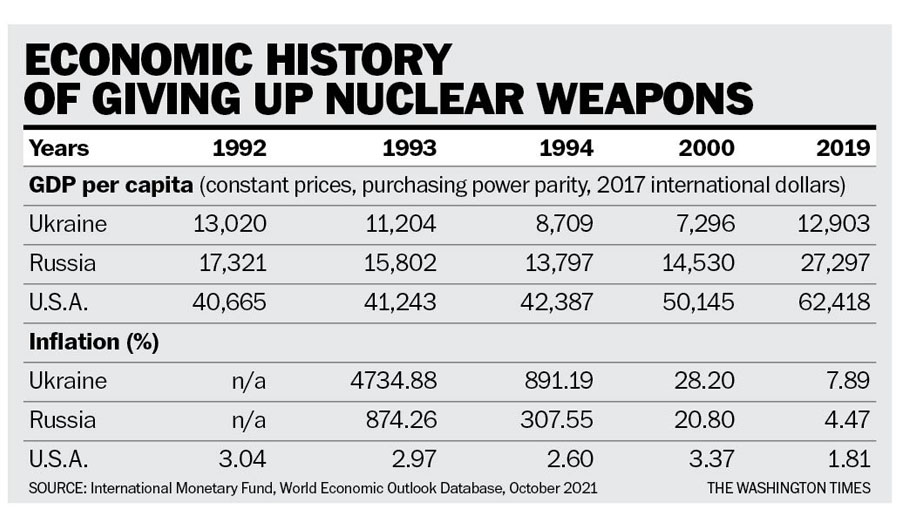OPINION:
In hindsight, it appears to have been a terrible decision for Ukraine to have given up its nuclear weapons back in 1994. During the early 1990s, I spent considerable time in Ukraine and Russia as an economic adviser to some members of the leadership in both countries, including acting Prime Minister Yegor Gaidar in Russia and Viktor Yushchenko, head of the central bank and later president of Ukraine. The economies of both Ukraine and Russia had collapsed as the old Soviet socialist/communist model became completely dysfunctional; yet, at that time, there was no capitalist economy to provide the necessary goods and services.
Ukraine was suffering hyper-inflation, and at one point prices were doubling every three days or so. The prices on restaurant menus would literally change a couple of times during the day. The IMF estimated that for the year of 1993 the inflation rate was roughly 5000% — as if it were possible to measure. During the height of the crisis, Mr. Yushchenko asked me to give him an assessment of the situation and what should be done. It became quickly obvious that the central bank did not have control over the money supply, in that many government agencies were issuing credits (promises to pay) without legislative or central bank authorization.
Those of us who had been advisers in the Eastern European countries had developed formulas for partially fixing the local currencies to the dollar or DMark (the West German currency) to bring inflation under control and rapidly privatize the real economy. Ukraine had a particular problem, as the Defense Minister told me, that one-third of the workers in Ukraine were employed in 13 large military factories (i.e., Ukraine had the world’s largest tank and missile factory). Many of the defense factories were in single-product company towns, which gave little opportunity for privatization.
The result was that Ukrainians suffered a much bigger drop in real incomes than most of the other former communist countries, including Russia. At the same time, the Clinton administration was concerned and focused on reducing nuclear proliferation. Ukraine, at that time, had the world’s third-largest nuclear arsenal — even though operational control remained under Russia.
Ukraine was bankrupt and the people were desperate. I recall one morning watching an open truck with loaves of bread and the driver selling quarter loaves to a long line of hungry people because they could not afford a whole loaf. The U.S. was pouring in aid, but it was not enough, so the decision was made to denuclearize Ukraine by the U.S. buying up the missiles and warheads for hundreds of millions of dollars.
The U.S. paid the Russians — who were also in a desperate economic situation — to dismantle the warheads and convert the uranium for use in power plants. Some of the Ukrainian leaders resisted giving up the nuclear warheads, but the money seemed more important to most of them, so the “Budapest Memorandum” was signed in December 1994.
At the time, it seemed like win-win-win. The Americans achieved their goal of reducing the number of nuclear states. The Russians received badly needed American dollars to bolster their economy and partially disarmed their neighbor. And the Ukrainians received a huge boost to their budget, which kept them from disintegrating.
Both the Ukrainian and Russian militaries had largely fallen apart and neither country was in a position to fight anyone. Russia had become an imperfect democracy under Yeltsin, with basic freedoms. European and American companies were encouraged to set up operations and joint-ventures in Russia and Ukraine, both to stabilize the economic situation and teach the Ukrainians and Russians how to operate in a capitalist world. (One example: The communists had very primitive accounting systems that provided little information — often intentionally. The big international accounting firms established offices in the newly freed countries, both to service the new enterprises and teach the locals such basic concepts as depreciation and discounted cash flow.)
In Budapest on Dec. 5, 1994, “The United States of America, the Russian Federation, and the United Kingdom of Great Britain and Northern Ireland … taking into account the commitment of Ukraine to eliminate all nuclear weapons from its territory… reaffirm their commitment to Ukraine … to respect the Independence and Sovereignty of the existing borders of Ukraine … to refrain from the threat of or use of force against the territorial or political independence of Ukraine.”
There are a number of other provisions in the memorandum that strengthen and make more operational the above-quoted provisions. It is unambiguously clear that Russian President Vladimir Putin has violated the agreement. The agreement also calls upon the U.S., U.K. and U.N. to provide assistance to Ukraine if it “should become a victim of an act of aggression,” without specifying the limits of that assistance.
As can be seen in the enclosed table, after a couple of difficult decades, Russia and Ukraine have been enjoying real economic growth in recent years, and inflation has been largely brought under control. But now, who is going to invest and do business with Russia if Mr. Putin is in charge? Decades of progress in two countries were destroyed in a matter of days by one evil man.
• Richard W. Rahn is chair of the Institute for Global Economic Growth and MCon LLC.





Please read our comment policy before commenting.